Did you know that a mere 2% increase in conversion rates can result in a 20% increase in revenue? As a SaaS company, optimizing your conversion rates is paramount to scaling your business. But how do you ensure that your strategies are effective and yield the desired results?
In this analytical deep dive, we’ll explore +11 proven tactics that leading SaaS companies have employed to boost their conversion rates. By the end of this read, you’ll have a comprehensive understanding of the why, how, and what of conversion optimization tailored specifically for the SaaS industry.
Whether you’re a startup or an established player, the insights shared here will equip you with actionable strategies to enhance your user acquisition and retention. We’ll delve into primary tactics like A/B testing, user experience enhancements, and secondary strategies that complement the core methods.
Stay with us as we unpack the intricacies of Conversion Optimization for SaaS Companies and set you on a path to exponential growth.
#1 Add a Request Callback Widget

A callback widget allows visitors to request a phone call from your team, providing an immediate response mechanism.
It will also allow you to speak with your customer by phone or video call which is a better way to build relationships.
This tool can capture leads at the peak of their interest.
It eliminates the waiting time for visitors, offering them a direct line to get their queries addressed.
Such widgets can be especially beneficial for B2B SaaS companies where potential customers might have specific questions before making a decision.
#2 Add SSO Login to your platform
Utilizing one-click social registration systems can lead to a significant increase in the number of accounts created.
Offer both social media logins (Facebook, Twitter, Google, LinkedIn, etc.) and traditional email-based registration.
#3 Consistent Messaging from Ad to Landing Page
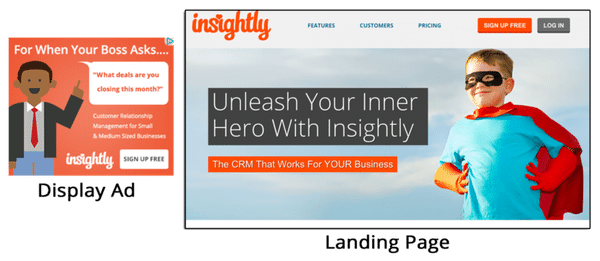
Ensure that the messaging on your landing page aligns with the ad copy that brought visitors there. This creates a seamless experience and sets clear expectations.
👉 Reduce Bounce Rates: Matching the messaging can decrease bounce rates as visitors are more likely to stay on a page that aligns with their initial expectations from the ad.
👉 Boost Conversion Rates: Consistent messaging can lead to higher conversion rates as it reinforces the message and call-to-action that initially attracted the visitor.
👉 Build Trust: When your ad copy and landing page messaging are in sync, it builds trust with the visitor, as they feel they are in the right place and that the brand is reliable.
#4 Display testimonials based on location.
Displaying testimonials that match the geography of the site visitor can significantly enhance trust.
Visitors are more likely to recognize and resonate with brands or individuals from their own region.
👉 Implement systems that automatically detect the visitor’s location and adjust the displayed testimonials accordingly. This ensures a personalized experience for every visitor.
#5 Experiment on your own: 7-days free trials increase sales and retention

#6 Leverage FOMO (Fear of Missing Out)
FOMO is a powerful psychological trigger. By showing users what they might miss out on, you can drive them to take action.
Show Real-Time Interactions: With tools like Fomo, you can display real-time customer interactions on your site, reinforcing the idea that others are taking advantage of what you offer.
Introduce Deadlines: Adding a time constraint, such as a limited-time offer, can further amplify the FOMO effect, pushing users to act before they miss out.
Highlight Benefits Over Features: Instead of just listing features, showcase the direct benefits users will receive, aligning with their desires and needs.
#7 Remove Checkout Steps
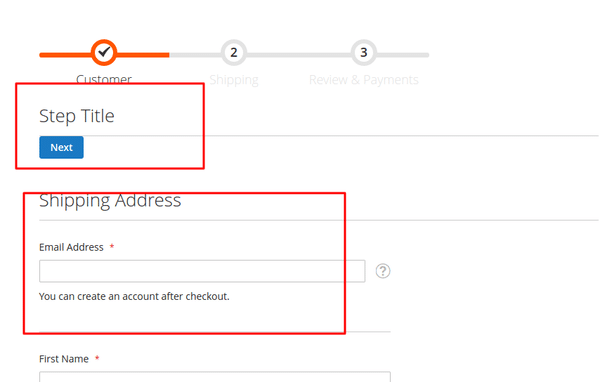
Streamlining the checkout or sign-up flow is crucial for SaaS companies. A complex or lengthy process can deter potential customers from completing their registration or purchase.
Reasons for Abandonment: Common deterrents include mandatory account creation, unexpected costs, and a confusing interface.
Simplify the Process: An ideal flow should be logical and concise. Avoid unnecessary steps or information requests that can create friction.
Guest Checkout/Sign-up: Offer an option for users to try the service without a full account setup. This reduces barriers to entry.
#8 Showcase Testimonials for each Persona
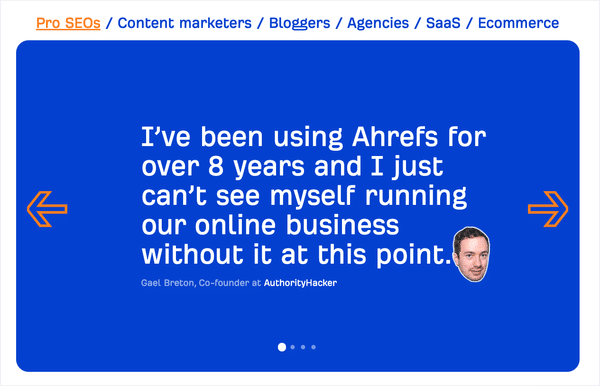
Ahrefs uses a widget that displays testimonials based on personas.
Each testimonial feature a Person on the Specifc role, for example for SaaS: Head of Marketer, Team Lead, etc.
Try if you can do the same!
Identify Key Personas: Start by identifying the primary personas or categories of your user base.
Collect Testimonials: Gather testimonials from users in each persona category. Ensure that these testimonials highlight the unique benefits and features relevant to that specific group.
Implement: Develop a widget or feature on your website that can detect or ask the user’s persona. Based on this information, display the relevant testimonials.
#9 Try fewer form fields instead of asking for too many

Human beings are inherently resistant to labor intensive tasks and this same idea also applies to filling out form fields.
Each field you ask for runs the risk of making your visitors turn around and give up.
Not everyone types at the same speed, while typing on mobile devices is still a chore in general.
👉 Question if each field is really necessary and remove as many fields as possible.
If you really have numerous optional fields, then also consider moving them after form submission on a separate page or state. It’s so easy to bloat up your forms, yet fewer fields will convert better.
via goodui.org
#10 Try ‘Benefit Buttons
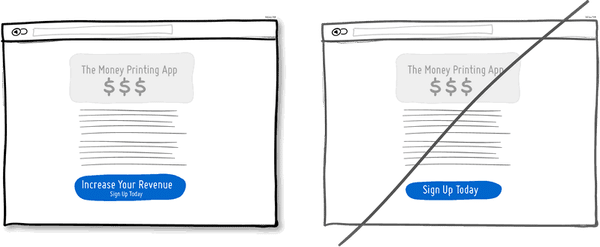
Instead of generic buttons like “Sign Up”, use “Save Money Now” to highlight the immediate value. Pair Action with Benefit: Position the benefit close to the action button, reinforcing the reason for the action. Use Task-Based Buttons Sparingly: For familiar actions in the interface, such as “Edit” or “Delete”, task-based labels are appropriate.
#11 Use ‘Message Match’ on your campaigns
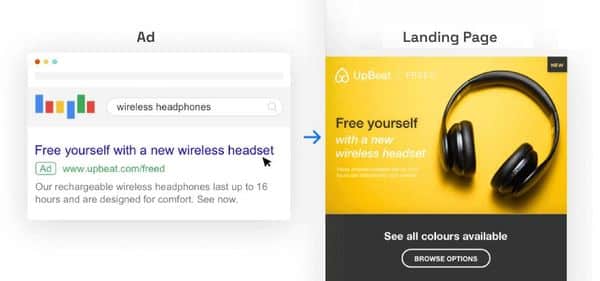
Boost conversion rates by ensuring the messaging/creative of your landing page matches that of your ads.
Avoid sending traffic to your homepage; it’s often filled with distractions and may not align with your ad’s messaging.
Direct traffic to a specific landing page tailored to match the ad’s messaging/creative.
Matching the ad’s messaging/creative with the landing page increases the ad’s relevancy and quality score.
A higher quality score can lead to a higher conversion rate (CR) and a lower cost per click (CPC).
This tactic is a win-win: it can improve the user experience and potentially reduce advertising costs.
Conclusion
In summary, conversion optimization is not just a buzzword; it’s a strategic approach that can significantly impact a SaaS company’s bottom line. From understanding user behavior to implementing data-driven strategies, the journey to optimizing conversions is both an art and a science.
As we’ve explored, there are multiple tactics at your disposal, each with its unique advantages. The key is to understand your audience, test relentlessly, and iterate based on insights.
To fuel your quest for growth, we’re excited to share this exclusive resource: “30 Days of Growth“. Take full advantage of this bundle for an unbounded growth journey!🎯
